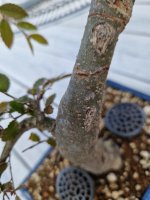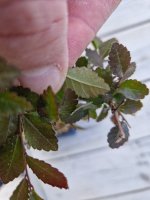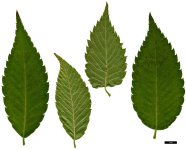I got this bonsai and it was marked zelkova, but I guessed it was wrongly marked since many experience this. Played around with chat gpt today that also placed it as a chinese elm, but in providing close up photos it instead said zelkova. So intrigued I turn to this community to understand how you tell them apart. Have already tried googling, but it seems hard to tell.
You are using an out of date browser. It may not display this or other websites correctly.
You should upgrade or use an alternative browser.
You should upgrade or use an alternative browser.
Japanese or chinese elm
- Thread starter sauk1
- Start date
NeedlesAndLeaves
Mame
This looks like a Chinese elm.
You can tell the difference if you compare it with the Zelkova leaves.
You can tell the difference if you compare it with the Zelkova leaves.
NeedlesAndLeaves
Mame
NeedlesAndLeaves
Mame
Shibui
Imperial Masterpiece
It's definitely a Chinese elm.
I assume you are in UK or EU where this mislabelling is intentional to get around a ban on importing elms but importing Zelkova is allowed.
Zelkova leaf is larger, longer and softer than Chinese elm. Some difference in serrations on the margins?
When seen in isolation there's not much difference but side by side, in the flesh, the differences are quite obvious.
I assume you are in UK or EU where this mislabelling is intentional to get around a ban on importing elms but importing Zelkova is allowed.
Zelkova leaf is larger, longer and softer than Chinese elm. Some difference in serrations on the margins?
When seen in isolation there's not much difference but side by side, in the flesh, the differences are quite obvious.
Bonsai Nut
Nuttier than your average Nut
Chinese elm. This was an easy one 
Chinese elm leaves are almost perfectly symmetrical and spear shaped, coming to a blunt point at the tips. If you look very closely, they will be very slightly asymmetrical at the base of the leaf.
Zelkova leaves tend to be longer, coming to a noticeable elongated point at the tip. The serrations on the edges of the leaf tend to be pointy - or at least pointier than Chinese elm. Base of the leaf is perfectly symmetrical.
Chinese elm leaves are almost perfectly symmetrical and spear shaped, coming to a blunt point at the tips. If you look very closely, they will be very slightly asymmetrical at the base of the leaf.
Zelkova leaves tend to be longer, coming to a noticeable elongated point at the tip. The serrations on the edges of the leaf tend to be pointy - or at least pointier than Chinese elm. Base of the leaf is perfectly symmetrical.
Last edited:
rockm
Spuds Moyogi
Also the source and form of the tree screams “Chinese Elm”. Twisty trunk tree imported as “zelkova” are almost always Chinese Elm hiding from import restrictions.
In my years in bonsai I have NEVER seen an actual imported mass produced zelkova bonsai. I have bought several actual zelkova bonsai over the years. They were exclusively sourced from landscape nurseries.
In my years in bonsai I have NEVER seen an actual imported mass produced zelkova bonsai. I have bought several actual zelkova bonsai over the years. They were exclusively sourced from landscape nurseries.
PA_Penjing
Chumono
rockm said it first, even without leaves I could promise you it was chinese elm by the trunk shape haha
Zelkova does not necessarily mean Japanese zelkova. There are several other, less popular, species of Zelkova such as Chinese, Caucasian and Cretan zelkova, which have leaves more similar to Chinese elm than Japanese zelkova, so the distinction is not always easy. In Europe, sometimes (rarely) Caucasian zelkova is sold as bonsai, which has leaves very similar to Chinese elm. The only difference is that Chinese elm leaves are usually more leathery and have more teeth on each side.
And Caucasian zelkova grows much larger than Chinese elm, but such young trees in bonsai containers are usually difficult to distinguish 100%.
But it is very likely that in your case it is indeed Chinese elm and not zelkova. It is definitely not Japanese zelkova.
In general, Caucasian zelkova could be an excellent bonsai, as it has an advantage over Chinese elm: it is more winter hardy and has more beautiful autumn colors (orange-yellow) and samlle elaves tahn Japanese zelkova. So I'm surprised why it's not popular with bonsai enthusiasts who swear only by Japanese zelkova.
And Caucasian zelkova grows much larger than Chinese elm, but such young trees in bonsai containers are usually difficult to distinguish 100%.
But it is very likely that in your case it is indeed Chinese elm and not zelkova. It is definitely not Japanese zelkova.
In general, Caucasian zelkova could be an excellent bonsai, as it has an advantage over Chinese elm: it is more winter hardy and has more beautiful autumn colors (orange-yellow) and samlle elaves tahn Japanese zelkova. So I'm surprised why it's not popular with bonsai enthusiasts who swear only by Japanese zelkova.
SeanS
Omono
- Messages
- 1,815
- Reaction score
- 6,236
- USDA Zone
- 9b
Let’s not overlook the typical mass produced blue Chinese pot that almost every single S-curve elm comes in.
Similar threads
- Replies
- 0
- Views
- 258






